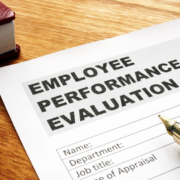Managing Employee Performance – Assessing Performance

This blog is part of a series of blogs focusing on the topic of “Managing Employee Performance”. Managing employee performance in the workplace is comprised of all of the interactions and activities that take place between an employer and an employee. These interactions and activities result in the achievement of goals and expectations, and more importantly, employee success and organizational success. The previous two blogs offered insights into how to set expectations. This blog will continue the topic of how to set expectations with a review of goal setting. We will now explore how to assess performance and provide employees with meaningful information on how they are doing.
Giving an Employee Feedback
The foundational purpose of feedback is to help modify a future action. In the case of employee performance in an organization, feedback is given to help a person succeed. This is accomplished by:
a) letting the employee know that they should continue a specific behavior. Doing so will enable them to continue meeting expectations (succeed). This can be called reinforcing feedback.
b) letting the employee know that a specific behavior is not meeting expectations. Dialogue with the employee to enable them to alter or modify future actions in order to meet expectations (succeed).
This concept seems straightforward. However, throughout my career I’ve encountered many managers who believe that if an employee is doing the job correctly there is no need to speak with them about their good performance because that’s what’s expected. Unfortunately, this kind of thinking can result in lowering the level of employee engagement and productivity.
What is the Value of Ongoing Progress Reports?
In their book “The Progress Principle”, Teresa Amabile and Steven Kramer1 share research into the value of giving ongoing progress reports (a.k.a. feedback) to employees. In the research, they reviewed the interactions that managers had with employees. They sorted the managers into two categories – those that provided ongoing progress reports and those that provided infrequent progress reports. The research results provided clear evidence that employees who reported to managers that provided regular progress reports experienced much higher levels of engagement and productivity. For the managers who chose not to provide regular progress reports, the levels of employee engagement and productivity were much lower. This research validates our intuitive assumption that employees have a desire to know how they are doing and would like to get feedback on how they’re doing on a regular basis.
Maintaining Dialogue
Many organizations seem to misunderstand the primary focus of managing employee performance. At the heart of this misunderstanding is the idea that the most important event in the performance management process is an annual meeting. This is where the manager spends most of the time talking about the past with supporting documentation to “fix” the person. In some cases the documents are sparse on facts and details. In some cases, there is back-and-forth dialogue. However, many employees experience a situation where the manager has already determined the employee’s rating.
The perception that can be created in this situation is that the employee’s point of view has little value in determining the overall outcome of how the employee is “rated”. In cases where there is significant underperformance, the organization introduces performance improvement plans (commonly referred to as PIPs) that are administered by the HR department. The lack of involvement and engagement with the employee’s perspective impedes the goal of achieving employee success and organizational success.
The most important event in assessing employee performance is the regular conversations you have when you observe their performance. This should be more of the primary focus than annual meetings where the emphasis is on tracking past performance.
The ongoing dialogue is the best way to help an employee succeed. Have intermittent meetings to review the conversations that have taken place in the past quarter or the past year. Developing a mindset and a system to manage employee performance that focuses on authentic, robust and helpful conversations will create better value for the organization. This is more beneficial than getting together once a year and filling out forms for the HR department.
Review
In summary, the first step in effectively managing employee performance is the process of setting expectations. Both the ongoing job accountabilities as well as the time framed goals. The second step is to assess employee performance. Subsequent blogs will offer insights on how to effectively manage conversations where the goal is to provide feedback to the employee that “lands”. We will also examine the importance of creating a motivating environment in order to help an employee succeed as part of an effective program for managing employee performance. As always, I welcome your feedback. You can connect with me via email or telephone or leave a comment right here on the site.
Until next time,
Dave





Leave a Reply
Want to join the discussion?Feel free to contribute!